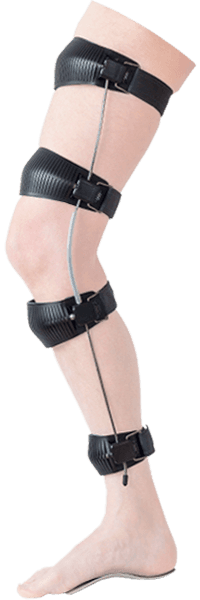UTX for people with weakened leg muscles
Valgus or varus knee
The UTX FS is designed to provide stability in the frontal plane. This is necessary for people who have an unstable
valgus (x-position) or
varus (o-position) of the knee. This occurs with
osteoarthritis of the knee. The cartilage of the knee is then degenerate. Usually, on one side of the knee, it is worse than the other side. If the degeneration is mainly on the inside of the knee, the knee will sink into the varus. As a result, the "bad" inside is even more loaded, which makes the degeneration process even faster. If the degeneration is mainly on the outside of the knee, the knee will sink into a valgus.
Instability extends to the ankle
If the complaints are limited to a valgus or varus of the knee, in most cases a knee orthosis, like the
GENUX from Ambroise are choosen. In very severe cases however, one chooses a long leg orthosis (like the UTX FS). This orthosis has a longer frame than a knee orthosis and therefore provides more stability. In addition, we often see that severe valgus or varus of the knee is accompanied by the extreme inward rotation of the leg around the ankle at a valgus, or just turning out extreme at a varus. In those cases, correction is already advisable from the level of the ankle. The UTX FS can do that.
This orthosis can be combined with the entire spectrum of ankle-foot solutions available at the UTX, for example, the
UTX ESF, which supports the ankle with an AFO. This also prevents the rotation of the orthosis, which happens somtimes by knee orthosis.
Combination with quadriceps weakness
Incidentally, reduced function of the
quadriceps (thigh muscle - responsible for keeping the knee stable while standing and walking phase) also often occurs in conjunction with osteoarthritis. This may occure because walking is more painfull, so you walk less, and the muscle weakens. If the quadriceps do not have enough function, there must be thought of the stability of the knee in flexion and extension. This can be done, for example, with the
UTX SWING that has been specially developed to allow safe, stable and natural walking in case of reduced control over the quadriceps.
Not only osteoarthritis
Instability of the knee not only occurs in osteoarthritis. People who have walked for a long time with a knee that is unstable or less stable in flexion sometimes also develop an instability. That's because the leg is consciously turning more outward (or more inward). This gives a slightly more stable position during the standing phase. In this way, the body compensates for the lack of control over the quadriceps. The price that the body has to pay for is that the load on the knee in the other plane (valgus or varus direction) is getting much bigger. This eventually leads to instability in valgus or varus. We see this for example a lot at
polio and
post-polio syndrome.
Not suitable in case of:
The UTX FS is not suitable for valgus or varus instabilities bigger than 10° which can not be corrected to at least 10°. A valgus instability of 20°, for example, is not a contraindication, provided that the knee is redressable (able to push back) to at least 10°.
 The UTX-FS[/caption]
The UTX-FS[/caption]